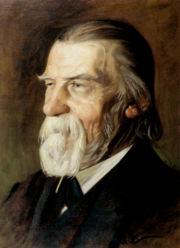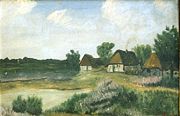
Wilhelm Raabe
Encyclopedia

Germany
Germany , officially the Federal Republic of Germany , is a federal parliamentary republic in Europe. The country consists of 16 states while the capital and largest city is Berlin. Germany covers an area of 357,021 km2 and has a largely temperate seasonal climate...
novelist, whose early works were published under the pseudonym of Jakob Corvinus, was born in Eschershausen
Eschershausen
Eschershausen is a municipality in the district of Holzminden, in Lower Saxony, Germany. It is situated approx. 20 km northeast of Holzminden, and 50 km south of Hanover....
(then in the Duchy of Brunswick
Duchy of Brunswick
Brunswick was a historical state in Germany. Originally the territory of Brunswick-Wolfenbüttel in the Holy Roman Empire, it was established as an independent duchy by the Congress of Vienna in 1815...
, now in the Holzminden
Holzminden (district)
Holzminden is a district in Lower Saxony, Germany. It is bounded by the districts of Hamelin-Pyrmont, Hildesheim and Northeim, and by the state of North Rhine-Westphalia .-History:...
District).
He served an apprenticeship at a bookseller's in Magdeburg
Magdeburg
Magdeburg , is the largest city and the capital city of the Bundesland of Saxony-Anhalt, Germany. Magdeburg is situated on the Elbe River and was one of the most important medieval cities of Europe....
for four years (1849–1854); but tiring of the routine of business, studied philosophy
Philosophy
Philosophy is the study of general and fundamental problems, such as those connected with existence, knowledge, values, reason, mind, and language. Philosophy is distinguished from other ways of addressing such problems by its critical, generally systematic approach and its reliance on rational...
at Berlin
Humboldt University of Berlin
The Humboldt University of Berlin is Berlin's oldest university, founded in 1810 as the University of Berlin by the liberal Prussian educational reformer and linguist Wilhelm von Humboldt, whose university model has strongly influenced other European and Western universities...
(1855–1857). While a student at that university he published his first work, Die Chronik der Sperlingsgasse (1857), which at once attained to great popularity.
Raabe next returned to Wolfenbüttel
Wolfenbüttel
Wolfenbüttel is a town in Lower Saxony, Germany, located on the Oker river about 13 kilometres south of Brunswick. It is the seat of the District of Wolfenbüttel and of the bishop of the Protestant Lutheran State Church of Brunswick...
, and then lived (1862–1870) in Stuttgart
Stuttgart
Stuttgart is the capital of the state of Baden-Württemberg in southern Germany. The sixth-largest city in Germany, Stuttgart has a population of 600,038 while the metropolitan area has a population of 5.3 million ....
, where he devoted himself entirely to authorship and wrote a number of novels and short stories; notably Unseres Herrgotts Kanzlei (1862); Der Hungerpastor (1864); Abu Telfan (1867) and Der Schüdderump (1870).
In 1870 Raabe removed to Brunswick
Braunschweig
Braunschweig , is a city of 247,400 people, located in the federal-state of Lower Saxony, Germany. It is located north of the Harz mountains at the farthest navigable point of the Oker river, which connects to the North Sea via the rivers Aller and Weser....
and published the narratives Horacker (1876); Pfisters Mühle
Pfisters Mühle
Pfisters Mühle: Ein Sommerferienheft is an 1884 novel by German author Wilhelm Raabe...
(1884) Das Odfeld (1889); Stopfkuchen (1891) – perhaps his masterpiece, Kloster Lugau (1894) and numerous other stories. Moving away from the idealized depictions of faith and family in his earlier, fairly typical Biedermeier
Biedermeier
In Central Europe, the Biedermeier era refers to the middle-class sensibilities of the historical period between 1815, the year of the Congress of Vienna at the end of the Napoleonic Wars, and 1848, the year of the European revolutions...
period works to sometimes gritty social realism
Social realism
Social Realism, also known as Socio-Realism, is an artistic movement, expressed in the visual and other realist arts, which depicts social and racial injustice, economic hardship, through unvarnished pictures of life's struggles; often depicting working class activities as heroic...
, his later works were much less popular than the earlier ones, which Raabe now came to regard as cheesy nonsense.
The distinguishing characteristic of Raabe's work is a genial humour reminiscent of Dickens
Charles Dickens
Charles John Huffam Dickens was an English novelist, generally considered the greatest of the Victorian period. Dickens enjoyed a wider popularity and fame than had any previous author during his lifetime, and he remains popular, having been responsible for some of English literature's most iconic...
; but often combined with realistic pessimism. His works, many of which double as fairy tales, have a recurrent theme of homecoming to the place of birth.
Raabe's 40th anniversary as a writer in 1894 was a matter of national celebration.
The critical edition of Raabe's complete works was published as Sämtliche Werke (Braunschweiger Ausgabe) Im Auftrage der Braunschweigischen Wissenschaftlichen Gesellschaft hrsg. von Karl Hoppe, beginning in 1965.
Works
- Die Chronik der Sperlingsgasse, 1856
- Ein Frühling, Der Weg zum Lachen, 1857
- Die alte Universität, Der Student von Wittenberg, Weihnachtsgeister, Lorenz Scheibenhart, Einer aus der Menge, 1858
- Die Kinder von Finkenrode, Der Junker von Denow, Wer kann es wenden?, 1859
- Aus dem Lebensbuch des Schulmeisterleins Michel Haas, Ein Geheimnis, 1860
- Auf dunkelm Grunde, Die schwarze Galeere, Der heilige Born, Nach dem großen Kriege, 1861
- Unseres Herrgotts Kanzlei, Das letzte Recht, 1862
- Eine Grabrede aus dem Jahre 1609, Die Leute aus dem Walde, Holunderblüte, Die Hämelschen Kinder, 1863
- Der Hungerpastor, Keltische Knochen, 1864
- Else von der Tanne, Drei Federn, 1865
- Die Gänse von Bützow, Sankt Thomas, Gedelöcke, 1866
- Abu Telfan; oder Heimkehr aus dem Mondgebirge, 1867
- Theklas Erbschaft, 1868
- Im Siegeskranze, 1869
- Der Schüdderump, Der Marsch nach Hause, Des Reiches Krone, 1870
- Der Dräumling, 1872
- Deutscher Mondschein, Christoph Pechlin, 1873
- Meister Autor oder Die Geschichten vom versunkenen Garten, Höxter und Corvey, 1874
- Frau Salome, Vom alten Proteus, Eulenpfingsten, 1875
- Die Innerste, Der gute Tag, Horacker, 1876
- Auf dem Altenteil, 1878
- Alte Nester, Wunnigel, 1879
- Deutscher Adel, 1880
- Das Horn von Wanza, 1881
- Fabian und Sebastian, 1882
- Prinzessin Fisch, 1883
- Villa Schönow, Pfisters Mühle, Zum wilden Mann, Ein Besuch, 1884
- Unruhige Gäste, 1885
- Im alten Eisen, 1887
- Das Odfeld, 1888
- Der Lar, 1889
- Stopfkuchen, 1891
- Gutmanns Reisen, 1892
- Kloster Lugau, 1894
- Die Akten des Vogelsangs, 1896
- Hastenbeck, 1899
- Altershausen (Fragment), 1902 (published 1911)
Wilhelm Raabe the painter

External links
- Die schwarze Galeere Free human-read audiobook (in the German original) from LibriVox
- Full text of books by Raabe at Projekt Gutenberg-DEProjekt Gutenberg-DEProjekt Gutenberg-DE is a collection of German language literary texts, distributed via the web and on CD-ROM. It is run by a small publishing company called Hille Partner, run by Gunter Hille, and its web presence is hosted by the weekly magazine Der Spiegel....

